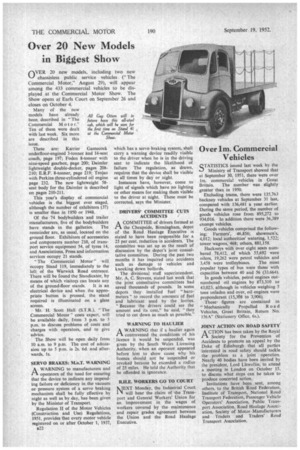Over lm. Commercial Vehicles
Page 56

If you've noticed an error in this article please click here to report it so we can fix it.
QTATISTICS issued last week by the 0.-) Ministry of Transport showed that at September 30, 1951, there were over 1im commercial vehicles in Great
Britain. The number was slightly greater than in 1950.
Excluding trams, there were 135,763 hackney vehicles at September 31 last, compared with 136,481 a year earlier. During the same period, the number of goods vehicles rose from 895,272 to 934,016. In addition there were 36,389 exempt vehicles.
Goods vehicles comprised the following: Farmers', 46,856; showmen's, 4,012; local authorities' watering, 1,522; tower wagons, 468; others, 881,158.
Hackneys with over eight seats numbered 78,412, of which 55,692 were oilers, 19,262 were petrol vehicles and 3,458 were trolleybuscs. The most popular types of bus were those with capacities between 40 and 56 (33,664).
In goods vehicles, petrol engines outnumbered oil engines by 873,310 to 43,023, although in vehicles weighing 5 tons unladen and over, oil engines were preponderant (15,308 to 3,906).
These. figures are contained in Mechanically Propelled Road Vehicles, Great Britain, Return No. 156A" (Stationery Office, 6s.).
JOINT ACTION ON ROAD SAFETY
ACTION has been taken by the Royal Society for the Prevention of Accidents to promote an appeal by the Duke of Edinburgh that all parties interested in road safety should tackle the problem as a joint operation. Nearly 40 bodies have been invited by the president, Lord Llewellin, to attend a meeting in London on October 15, to discuss what steps can be taken to produce concerted action, Invitations have been sent, among others, to the British Road Federation, Institute of Transport, National Road Transport Federation, Passenger Vehicle Operators' Association, Public Transport Association, Road Haulage Association, Society of Motor Manufacturers and Traders and Traders' Road Transport Association.




































































































































































